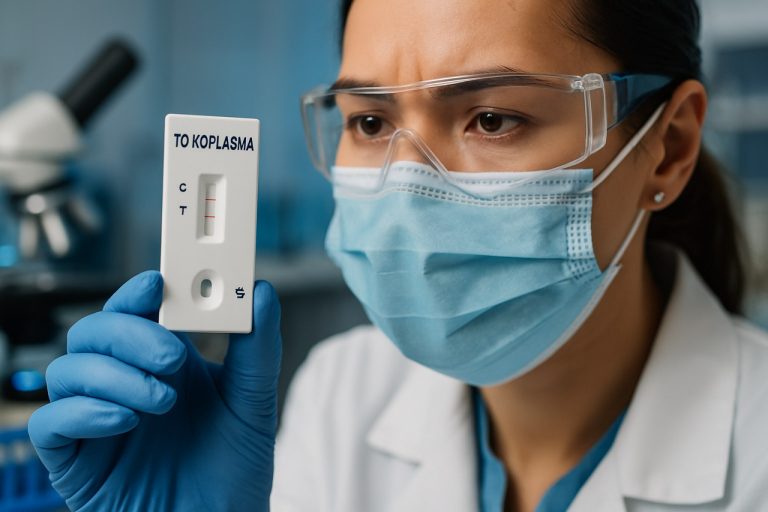
Unlocking the Secrets of Toxoplasma gondii Detection Technologies: How Cutting-Edge Innovations Are Transforming Diagnosis and Disease Control. Discover the Tools Shaping the Next Era of Parasitic Infection Management.
- Introduction: The Global Impact of Toxoplasma gondii
- Traditional Detection Methods: Strengths and Limitations
- Molecular Diagnostics: PCR and Beyond
- Serological Assays: ELISA, IFA, and New Developments
- Point-of-Care and Rapid Testing Innovations
- Emerging Technologies: Biosensors, CRISPR, and Nanotechnology
- Comparative Analysis: Sensitivity, Specificity, and Practicality
- Challenges in Detection: From Sample Collection to Interpretation
- Future Directions: AI Integration and Next-Gen Platforms
- Conclusion: The Road Ahead for Toxoplasma gondii Detection
- Sources & References
Introduction: The Global Impact of Toxoplasma gondii
Toxoplasma gondii is a globally prevalent protozoan parasite responsible for toxoplasmosis, a disease with significant public health and veterinary implications. It infects nearly one-third of the world’s human population, often asymptomatically, but can cause severe complications in immunocompromised individuals and during pregnancy, leading to congenital toxoplasmosis and associated birth defects. The parasite’s zoonotic nature, with felines as definitive hosts and a wide range of intermediate hosts including humans and livestock, underscores its complex transmission dynamics and the necessity for robust surveillance and control measures World Health Organization.
Accurate and timely detection of T. gondii is critical for effective disease management, outbreak prevention, and food safety assurance. Traditional diagnostic methods, such as serological assays and microscopic examination, have been widely used but are often limited by sensitivity, specificity, and the ability to distinguish between acute and chronic infections. In recent years, advances in molecular biology, immunodiagnostics, and biosensor technologies have revolutionized the detection landscape, enabling more rapid, sensitive, and specific identification of the parasite in clinical, veterinary, and food samples Centers for Disease Control and Prevention.
This section provides an overview of the global impact of T. gondii and highlights the critical role of evolving detection technologies in mitigating the burden of toxoplasmosis. The integration of innovative diagnostic tools is essential for improving surveillance, guiding public health interventions, and reducing the risk of transmission across human and animal populations.
Traditional Detection Methods: Strengths and Limitations
Traditional detection methods for Toxoplasma gondii have long served as the foundation for clinical and epidemiological diagnosis. The most widely used approaches include serological assays, such as the Sabin-Feldman dye test, enzyme-linked immunosorbent assay (ELISA), and indirect fluorescent antibody test (IFAT). These methods primarily detect host antibodies (IgG, IgM) against T. gondii, providing valuable information about exposure and infection status. Serological tests are generally cost-effective, relatively simple to perform, and suitable for large-scale screening, making them indispensable in both clinical and public health settings Centers for Disease Control and Prevention.
However, traditional serological methods have notable limitations. They often cannot distinguish between acute and chronic infections, as IgG antibodies may persist for life, and IgM can sometimes remain detectable long after acute infection has resolved. Cross-reactivity with other pathogens can also lead to false positives, reducing specificity. Furthermore, immunocompromised patients may not mount a detectable antibody response, resulting in false negatives World Health Organization.
Microscopic examination of tissue or body fluids for T. gondii tachyzoites or cysts is another traditional method, but it suffers from low sensitivity and requires skilled personnel. Bioassays, such as mouse inoculation, are highly sensitive but are time-consuming, ethically challenging, and impractical for routine diagnostics National Center for Biotechnology Information. Overall, while traditional methods remain valuable, their limitations have driven the development of more advanced molecular and immunological detection technologies.
Molecular Diagnostics: PCR and Beyond
Molecular diagnostics have revolutionized the detection of Toxoplasma gondii, offering high sensitivity and specificity compared to traditional serological and microscopic methods. Polymerase chain reaction (PCR) remains the cornerstone of molecular detection, enabling the amplification of specific T. gondii DNA sequences from a variety of clinical samples, including blood, cerebrospinal fluid, amniotic fluid, and tissue biopsies. Real-time quantitative PCR (qPCR) further enhances diagnostic accuracy by quantifying parasite load, which is particularly valuable in monitoring congenital infections and immunocompromised patients Centers for Disease Control and Prevention.
Beyond conventional PCR, advanced molecular techniques are emerging. Loop-mediated isothermal amplification (LAMP) offers rapid, equipment-light detection suitable for field and resource-limited settings, with comparable sensitivity to PCR World Health Organization. Digital PCR (dPCR) provides absolute quantification of T. gondii DNA, improving detection in samples with low parasite burden and reducing false negatives. Multiplex PCR assays allow simultaneous detection of T. gondii alongside other pathogens, streamlining differential diagnosis in clinical practice National Center for Biotechnology Information.
Despite these advances, challenges remain, including the need for standardized protocols, quality control, and the risk of contamination leading to false positives. Nevertheless, the integration of molecular diagnostics, particularly PCR-based and next-generation methods, continues to enhance the early and accurate detection of T. gondii, supporting timely intervention and improved patient outcomes.
Serological Assays: ELISA, IFA, and New Developments
Serological assays remain the cornerstone for the detection of Toxoplasma gondii infection, primarily due to their sensitivity, specificity, and adaptability to high-throughput screening. The enzyme-linked immunosorbent assay (ELISA) is widely used for both clinical and epidemiological purposes, enabling the detection of specific IgG and IgM antibodies against T. gondii. ELISA’s advantages include automation potential, quantitative results, and the ability to process large sample volumes efficiently. However, cross-reactivity with other pathogens and the window period before antibody development can limit its diagnostic accuracy in acute infections Centers for Disease Control and Prevention.
The indirect fluorescent antibody (IFA) test is another established serological method, offering high sensitivity and specificity by visualizing antibody-antigen interactions under a fluorescence microscope. IFA is particularly valuable for confirming equivocal ELISA results, though it is more labor-intensive and requires specialized equipment and expertise World Health Organization.
Recent developments in serological diagnostics include the use of recombinant antigens and multiplex platforms, which enhance specificity and allow simultaneous detection of multiple antibody classes or pathogens. Lateral flow immunoassays and biosensor-based technologies are also emerging, providing rapid, point-of-care solutions with minimal technical requirements. These innovations aim to overcome the limitations of traditional assays, such as false positives and delayed seroconversion, and are particularly promising for use in resource-limited settings National Center for Biotechnology Information.
Point-of-Care and Rapid Testing Innovations
Recent advancements in point-of-care (POC) and rapid testing technologies have significantly improved the detection of Toxoplasma gondii, particularly in resource-limited and clinical settings where timely diagnosis is critical. Traditional serological assays, such as ELISA and indirect fluorescent antibody tests, though reliable, often require laboratory infrastructure and trained personnel, limiting their utility in field conditions. In contrast, POC tests, including lateral flow immunoassays (LFIAs) and microfluidic platforms, offer rapid, user-friendly, and cost-effective alternatives for the detection of T. gondii antibodies or antigens in blood, serum, or other biological samples.
LFIAs, commonly known as rapid diagnostic tests (RDTs), have been developed to detect both IgM and IgG antibodies against T. gondii, providing results within 15–30 minutes. These tests are particularly valuable for screening pregnant women and immunocompromised patients, where early intervention can prevent severe outcomes. Recent innovations include the integration of nanomaterials to enhance sensitivity and the use of smartphone-based readers for semi-quantitative analysis, further increasing accessibility and accuracy Centers for Disease Control and Prevention.
Microfluidic devices represent another frontier, enabling multiplexed detection and requiring minimal sample volumes. These platforms can be integrated with isothermal amplification techniques, such as loop-mediated isothermal amplification (LAMP), to detect T. gondii DNA directly at the point of care, bypassing the need for complex thermal cyclers World Health Organization. Collectively, these innovations are transforming T. gondii diagnostics, making them more accessible, rapid, and suitable for decentralized healthcare environments.
Emerging Technologies: Biosensors, CRISPR, and Nanotechnology
Emerging technologies are revolutionizing the detection of Toxoplasma gondii, offering rapid, sensitive, and specific alternatives to conventional serological and molecular methods. Among these, biosensors have gained significant attention due to their ability to provide real-time, point-of-care diagnostics. Electrochemical and optical biosensors, for instance, utilize antibodies or aptamers specific to T. gondii antigens, enabling detection at very low concentrations in clinical samples. These platforms are being miniaturized for field use, enhancing accessibility in resource-limited settings (National Center for Biotechnology Information).
CRISPR-based detection systems represent another breakthrough. By leveraging the high specificity of CRISPR-Cas systems, researchers have developed assays that can identify T. gondii DNA with remarkable accuracy. These assays often couple CRISPR-mediated recognition with isothermal amplification, producing results in under an hour and requiring minimal equipment. Such innovations are particularly promising for early diagnosis and outbreak monitoring (Nature Research).
Nanotechnology is also making significant inroads. Nanoparticles, such as gold or magnetic nanoparticles, are being engineered to enhance signal detection in immunoassays and PCR-based methods. These nanomaterials improve sensitivity and reduce assay time, while also enabling multiplexed detection of multiple pathogens in a single test. The integration of nanotechnology with microfluidic devices further supports the development of portable, automated platforms for T. gondii detection (Elsevier).
Collectively, these emerging technologies hold the potential to transform T. gondii diagnostics, making them faster, more accurate, and more widely accessible.
Comparative Analysis: Sensitivity, Specificity, and Practicality
A comparative analysis of Toxoplasma gondii detection technologies centers on three critical parameters: sensitivity, specificity, and practicality. Molecular methods, particularly polymerase chain reaction (PCR)-based assays, are renowned for their high sensitivity and specificity, capable of detecting minute quantities of T. gondii DNA in clinical and environmental samples. Real-time PCR further enhances quantification and reduces contamination risk, making it a gold standard in many diagnostic laboratories. However, these methods require specialized equipment and trained personnel, limiting their practicality in resource-limited settings (Centers for Disease Control and Prevention).
Serological assays, such as enzyme-linked immunosorbent assay (ELISA) and indirect fluorescent antibody tests (IFAT), are widely used for screening due to their ease of use and cost-effectiveness. They offer good sensitivity and specificity for detecting anti-T. gondii IgG and IgM antibodies, which is valuable for epidemiological studies and prenatal screening. However, serology cannot reliably distinguish between acute and chronic infections, and cross-reactivity with other pathogens can reduce specificity (World Health Organization).
Emerging technologies, such as loop-mediated isothermal amplification (LAMP) and biosensor-based platforms, promise rapid, sensitive, and field-deployable detection. While these methods show comparable sensitivity to PCR and are more practical for point-of-care use, their widespread adoption is still limited by validation and standardization challenges (National Center for Biotechnology Information).
In summary, while molecular methods excel in sensitivity and specificity, serological and emerging technologies offer greater practicality for large-scale or field applications. The choice of detection method should be guided by the clinical context, available resources, and the specific diagnostic question.
Challenges in Detection: From Sample Collection to Interpretation
Detecting Toxoplasma gondii presents a series of challenges that span the entire diagnostic workflow, from sample collection to result interpretation. One major hurdle is the choice and handling of biological samples. T. gondii can be detected in blood, cerebrospinal fluid, amniotic fluid, or tissue biopsies, but the parasite’s low abundance and intermittent presence in these matrices can lead to false negatives. Proper sample storage and transport are critical, as degradation of nucleic acids or antigens can compromise test sensitivity and specificity Centers for Disease Control and Prevention.
Another challenge lies in the diversity of detection technologies. Serological assays, such as ELISA and agglutination tests, are widely used but may not distinguish between acute and chronic infections, and can yield cross-reactivity with other pathogens. Molecular methods like PCR offer higher sensitivity and specificity, yet are susceptible to contamination, require technical expertise, and may not be standardized across laboratories World Health Organization. Additionally, PCR’s effectiveness depends on the presence of sufficient parasite DNA, which is not always guaranteed in clinical samples.
Interpretation of results adds another layer of complexity. Serological profiles can be ambiguous, especially in immunocompromised patients or pregnant women, where misinterpretation can have serious consequences. Molecular results must be correlated with clinical findings, as detection of parasite DNA does not always indicate active infection. These challenges underscore the need for improved protocols, robust quality control, and the integration of multiple diagnostic approaches to enhance the reliability of T. gondii detection European Centre for Disease Prevention and Control.
Future Directions: AI Integration and Next-Gen Platforms
The integration of artificial intelligence (AI) and next-generation diagnostic platforms is poised to revolutionize Toxoplasma gondii detection technologies. AI-driven image analysis, particularly in conjunction with digital microscopy and high-throughput screening, can significantly enhance the sensitivity and specificity of parasite identification in clinical samples. Machine learning algorithms are being developed to automatically recognize morphological features of T. gondii in stained slides, reducing human error and expediting diagnosis. Furthermore, AI can assist in interpreting complex serological and molecular data, enabling more accurate differentiation between acute and chronic infections.
Next-generation sequencing (NGS) platforms, when combined with AI-based bioinformatics pipelines, offer the potential for comprehensive genotyping and detection of low-abundance T. gondii DNA in diverse sample types. These approaches can facilitate epidemiological surveillance and outbreak tracking with unprecedented resolution. Additionally, the development of portable, point-of-care devices leveraging microfluidics and AI-powered data analysis could democratize access to rapid and reliable T. gondii diagnostics, especially in resource-limited settings.
Despite these promising advances, challenges remain in standardizing AI models across laboratories and ensuring the quality of training datasets. Regulatory frameworks will need to adapt to validate and approve AI-assisted diagnostic tools. Continued interdisciplinary collaboration between parasitologists, data scientists, and engineers will be essential to realize the full potential of these technologies in clinical and public health contexts (World Health Organization; Centers for Disease Control and Prevention).
Conclusion: The Road Ahead for Toxoplasma gondii Detection
The landscape of Toxoplasma gondii detection technologies has evolved significantly, yet several challenges and opportunities remain on the horizon. While conventional serological and molecular assays have provided reliable means for diagnosis, their limitations in sensitivity, specificity, and accessibility—especially in resource-limited settings—underscore the need for continued innovation. Recent advances in biosensor platforms, isothermal amplification methods, and CRISPR-based diagnostics offer promising avenues for rapid, point-of-care detection with high accuracy and minimal technical requirements. Integration of these novel technologies with digital health tools and portable devices could further democratize access to timely diagnosis, particularly in endemic regions and among vulnerable populations.
Looking forward, the road ahead for T. gondii detection will likely be shaped by interdisciplinary collaboration, combining expertise in molecular biology, engineering, and data science. The development of multiplexed assays capable of simultaneously detecting multiple pathogens, as well as the incorporation of artificial intelligence for data interpretation, may enhance diagnostic efficiency and clinical decision-making. Furthermore, the establishment of standardized protocols and quality control measures will be essential to ensure the reliability and comparability of results across different settings and platforms.
Ultimately, the future of T. gondii detection technologies hinges on balancing innovation with affordability, scalability, and user-friendliness. Continued investment in research, validation, and implementation will be crucial to translating technological breakthroughs into tangible public health benefits, reducing the global burden of toxoplasmosis. For further information on current and emerging detection methods, refer to resources from the Centers for Disease Control and Prevention and the World Health Organization.
Sources & References
- World Health Organization
- Centers for Disease Control and Prevention
- National Center for Biotechnology Information
- Nature Research
- European Centre for Disease Prevention and Control



